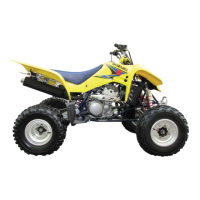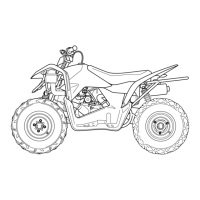5-12 COOLING AND LUBRICATION SYSTEM
THERMOSTAT
REMOVAL
• Drain a small amount of engine coolant. (%2-14)
• Place a rag under the thermostat case.
• Remove the thermostat case.
• Remove the thermostat.
INSPECTION
Inspect the thermostat pellet for signs of cracking.
Test the thermostat at the bench for control action, in the follow-
ing manner.
• Immerse the thermostat
1 in the water contained in a beaker,
as shown in the illustration. Note that the immersed thermo-
stat is in suspension. Heat the water by placing the beaker on
a stove and observe the rising temperature on a thermometer
2.
• Read the thermometer just when opening the thermostat. This
reading, which is the temperature level at which the thermo-
stat valve begins to open, should satisfy the standard value.
$ Thermostat valve opening temperature
Standard: Approx. 75°C (167 °F)
• Keep on heating the water to raise its temperature.
• Just when the water temperature reaches specified value, the
thermostat valve should have lifted by at least 6.0 mm (0.24 in).
$ Thermostat valve lift
Standard: Over 6.0 mm at 90°C (Over 0.24 in at 194°F)
• A thermostat failing to satisfy either of the two requirements
(start-to-open temperature and valve lift) must be replaced
with a new one.
INSTALLATION
• Install the thermostat in the reverse order of removal.
• Apply engine coolant to the rubber seal on the thermostat.
• After installing the thermostat, be sure to add engine coolant.
(%2-14)
• Install the front fender.
Water
String
Valve lift

